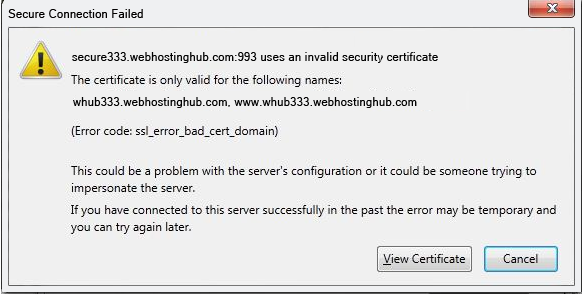Update to SSL Certificates - Certificate Warnings
ALERT: Customers may be receiving SSL Certificate Warnings in their email clients.
CAUSE: Our System Administrators periodically update the Shared SSL certificates on Web Hosting Hub servers.
Who is affected? This affects email accounts that are using the secure email server settings, without using the shared SSL certificate.
You might get an SSL warning if you tried to connect over SSL to the email server using your domain, like mail.example.com
If you instead, use the shared SSL of your server to connect, like ehub34.webhostinghub.com this can prevent you from having to accept an exception in your mail client anytime we renew the shared SSL.
Update information on the Shared SSL Certificates

The certificate update occurred at 2014.04.14 11:30am EST. SSL warnings that appear are related to the renewal of the Shared SSL certificate for several severs, and is not an actual problem. This is a normal result of updating server SSL certificates. They are typically renewed on an annual basis.
- If you are getting this warning in an internet browser or other email client, you will need to approve the certificate. This warning is normal as the certificate has been recently updated. The information stored on your computer simply needs to be updated to the new certificate.
- If you are getting this warning in Thunderbird, simply go to the warning and accept the new certificate. This will update the information in ThunderBird and prevent the warning from re-appearing.
- If you are seeing a certificate warning in the Outlook email client, you can accept the certificate, but you may get prompted again if Outlook performs an AutoDiscover operation. Microsoft has a possible work-around that can be found here. Go to method 4. You will be required to have access and be able to edit the registry. These changes are recommended by Microsoft and Web Hosting Hub is not responsible if these modifications have adverse affects on your computer.
If you have been inconvenienced by the SSL warnings please accept our apologies. Thank you for your patience and understanding!
Comments
|
n/a Points
|
2014-03-19 5:05 pm
Good Morning. In fact not very good indeed because since yesterday we here at the company still have no mail under the @gemmscore.com domain. How long can take to renew a certificate that void February the 23rd according with the information? Sorry but this is unnaceptable. |

Staff 16,266 Points
|
2014-03-19 6:21 pm
Hello Gabe,
There should be no issue with email after accepting the new certificate. After following the instructions above, the new certificate will be stored onto your computer, replacing the old one. After that, your email client should connect normally. If there are other issue with your email or email clients, please contact our support department for individual assistance. Kindest Regards, Scott M |

Staff 1,846 Points
|
2014-03-21 8:41 pm
Should the article include a link for Mac Mail as well? - http://support.apple.com/kb/PH11706
|
|
n/a Points
|
2014-04-12 4:05 am
The email I received stated fairly clearly that those using the shared SSL are the ones who ARE likely to receive the warning.But the introductory statement on this page states that using the shared SSL will "PREVENT you from having to accept the exception." This seems to say that those using shared SSL are NOT likely to receive the warning.Could you please clarify. (I'm not having any problems. I just want to understand the process unequivocally.)Thank you. |
|
Staff 17,314 Points
|
2014-04-12 7:16 am
Hello William,
Just to clarify, if you are using the actual server name (e.g. ehub34.webhostinghub.com) as opposed to your domain name, then you would not need to update the certificate because the warning would not show. So, if you were using the server name, it would "prevent" the warning from appearing. Sorry again for the confusion! Regards, Arnel C. |

We value your feedback!
There is a step or detail missing from the instructions.
The information is incorrect or out-of-date.
It does not resolve the question/problem I have.
new! - Enter your name and email address above and we will post your feedback in the comments on this page!